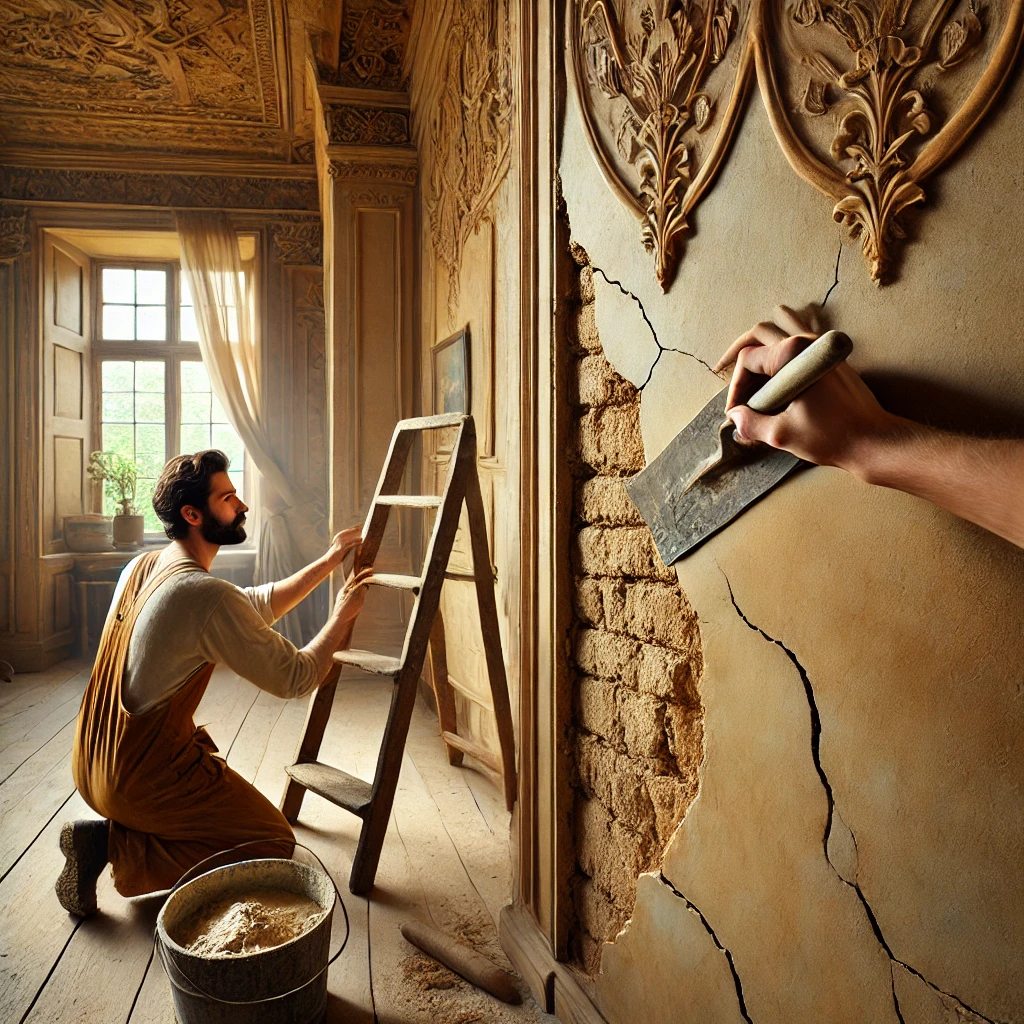Old homes are timeless treasures, blending craftsmanship and history. Yet, their plaster walls—often cracked, bulging, or water-stained—demand urgent attention. Ignoring plaster damage risks structural decay, lost heritage, and costly renovations. This guide dives deeper than competitors, revealing why plaster repair matters, how to tackle it, and when to call professionals—ensuring your home remains a masterpiece for generations.
The Critical Role of Plaster in Historic Homes
1. Historical Significance & Craftsmanship
Pre-1950s homes relied on plaster—a hand-troweled blend of lime, sand, and horsehair—applied over wood lath. Unlike modern drywall, plaster was artistry in motion, creating ornate ceilings, medallions, and smooth curves. Restoring original plaster preserves:
- Architectural authenticity (critical for heritage listings).
- Resale value (buyers pay premiums for intact historical features).
- Craftsmanship (modern techniques can’t replicate 19th-century textures).
2. Structural & Functional Advantages
Plaster isn’t just pretty—it’s practical:
- Fire Resistance: Lime plaster withstands 1,200°F+ flames, buying critical escape time.
- Soundproofing: 3x thicker than drywall, plaster muffles noise between rooms.
- Insulation: Traps air pockets, reducing energy bills by 15-20% compared to drywall.
Top 4 Plaster Problems in Old Homes (and Hidden Risks)
1. Cracks & Hairline Fractures
- Causes: Seasonal expansion, foundation settling, or seismic shifts.
- Risks: Small cracks let moisture seep into walls, rotting lath and breeding mold.
2. Bulging or Detached Plaster
- Causes: Rusted lath nails, humidity swelling wooden lath, or improper past repairs.
- Risks: Entire sections collapse if ignored, exposing wiring and insulation.
3. Holes & Missing Sections
- Causes: Accidental impacts, outdated wiring upgrades, or pest damage.
- Risks: Exposed lath attracts termites and weakens wall integrity.
4. Water Damage & Mold
- Causes: Leaky roofs, burst pipes, or poor ventilation.
- Risks: Black mold spores (like Stachybotrys) trigger asthma, allergies, and chronic illness.
Why Plaster Repair Beats Replacement Every Time
1. Cost Savings
- Repair Costs: 200–200–600 for localized fixes vs. $8,000+ for full-wall replacement.
- Example: Patching a 10 sq.ft. area costs 45inmaterials;replacingwithdrywallruns45inmaterials;replacingwithdrywallruns300+ (labor + disposal fees).
2. Eco-Friendly Preservation
- Waste Reduction: Restoring 500 sq.ft. of plaster saves 1.2 tons of landfill waste vs. demolition.
- Carbon Footprint: Lime plaster production emits 80% less CO₂ than gypsum drywall.
3. Durability That Outlasts Drywall
- Lifespan: Repaired plaster lasts 50–100 years; drywall needs replacing every 25–30.
- Humidity Resistance: Lime plaster “breathes,” preventing moisture buildup—critical in humid climates.
Step-by-Step Plaster Repair: Beyond Basic Patching
1. Assess Damage Like a Pro
- Tools: Flashlight, utility knife, moisture meter.
- Pro Tip: Tap walls with a rubber mallet—hollow sounds mean detached plaster.
2. Stabilize Loose Sections
- Materials: Plaster washers (stainless steel), 1.5” drywall screws.
- Method: Secure sagging plaster to lath with washers, then apply bonding agent.
3. Fill Cracks & Holes
- Products: Use Structo-Lite for base coats (lightweight and fast-drying) and Diamond Veneer Finish for smooth surfaces.
- Technique:
- Layer 1: Press plaster into lath gaps using a hawk and trowel.
- Layer 2: Skim coat with finish plaster, blending edges with a wet brush.
4. Restore Historical Texture
- Swirls/Knockdown: Mimic original textures with a stiff-bristle brush or sponge.
- Ornamental Repairs: Use silicone molds to recreate damaged crown molding sections.
When to Hire a Professional Plasterer
1. Large-Scale Detachment
If over 30% of the wall is sagging, DIY fixes risk collapse. Pros use industrial adhesives and reinforcement mesh.
2. Lead Paint Concerns
Pre-1978 plaster often contains lead. Certified abatement teams safely remove hazardous layers.
3. Historic Home Regulations
Heritage-listed properties may require permits and approved contractors to maintain compliance.
Conclusion:
Plaster repair isn’t optional—it’s a safeguard for your home’s safety, value, and legacy. By addressing cracks early and hiring experts for complex jobs, you’ll avoid five-figure renovation bills and keep your home’s history alive.
For more expert home repair tips, visit Problem Fixer Blog!
FAQs:
Q1: Can I Use Drywall to Patch Plaster?
No—drywall expands differently, causing cracks. Use lime-based plaster for seamless blends.
Q2: How Long Does Plaster Repair Take?
- Small cracks: 2–3 hours (including drying).
- Full-wall restoration: 3–5 days (multi-layer curing).
Q3: Will Repaired Plaster Crack Again?
Properly mixed and applied plaster lasts decades. Use fiberglass mesh tape over seams to prevent recracking.

Pingback: Commercial Window Cleaning: A Complete Guide